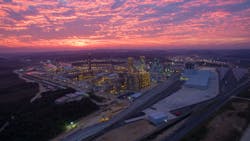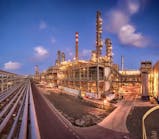US ethane moving to Braskem Idesa’s Mexico petrochemical complex
Braskem Idesa SAPI, a joint venture of Braskem SA, Sao Paulo, and Groupo Idesa SA de CV, Mexico City, has started receiving imports of ethane from the US at its Nanchital petrochemical complex in the Coatzacoalcos-Nanchital region of Mexico’s state of Veracruz (OGJ Online, June 24, 2016).
Braskem Idesa has now received its first shipment of ethane, which will be used as feedstock for production of polyethylene at the Nanchital complex, Braskem said on Feb. 10.
Requiring an overall investment of about $4 million, the project to bring US ethane feedstock to the Nanchital manufacturing site will enable Braskem Idesa to import up to 12,800 b/d of ethane, which represents 19% of the complex’s ethane needs, Braskem said.
Braskem identified neither the volume of the first ethane shipment received at the complex nor a specific producer from which it purchased the feedstock.
In its third-quarter 2019 earnings report to investors released in November 2019, Braskem said the Braskem Idesa JV was investing $2.4 million in logistics infrastructure to enable US ethane imports to the Nanchital complex to expand capacity utilization of the site’s 1.05 million-tonnes/year ethane cracker.
To ensure feasibility of fast-tracking the first phase of the ethane-imports project, Braskem Idesa executed agreements with logistics operator Smart Pass and Énestas SA de CV, which specializes in cryogenic gas transportation. As part of the agreements, Smart Pass was to be responsible for receiving liquid ethane at the docks of the Port of Coatzacoalcos and for unloading it from vessels into cryogenic tanks, from where Énestas would transport ethane by trucks about 10-12 km Braskem Idesa’s complex to be stored in existing tanks and regasified for use in the production process.
Ethane imports to the complex during this first phase could reach up to 25,400-b/d, or 38%, of its annual feedstock requirements, Braskem added.
At the time of the November earnings release, Braskem said that Braskem Idesa was in advanced negotiations with an unidentified seller to possibly sign a long-term agreement for the US ethane supplies; otherwise, the operator would secure ethane from the spot market.
Second-phase development
Braskem also told investors Braskem Idesa is evaluating a second-phase, higher-capacity leg of its project to increase imports of US ethane. The scope of the second-phase development would include construction of an 30,000-50,000-b/d liquid ethane import terminal and associated pipeline to deliver supplies directly to the Nanchital petrochemical complex, according to a Dec. 6, 2019, presentation from Braskem.
While it disclosed no further details regarding the proposed second phase, Braskem did say construction on the planned terminal and pipeline—presumably, if approved—would begin early in 2020 for targeted startup no later than yearend 2021.
Ethylene expansion
Alongside development of the second-phase imports project, Braskem said on Dec. 6, 2019, that Braskem Idesa also plans to expand ethylene capacity of the Nanchital petrochemical complex between 10-20% during 2021. Further details regarding the proposed capacity expansion, however, were not revealed.
Fully commissioned in 2016, Braskem Idea’s Nanchital complex—which was initially to receive 66,000 b/d of ethane under a 20-year supply agreement with state-owned Petroleos Mexicanos to feed the complex’s cracker—also includes two high-density polyethylene plants with capacities of 400,000 tpy and 350,000 tpy, respectively, as well as a 300,000-tpy low-density polyethylene plant (OGJ Online, Apr. 8, 2016).
By yearend 2019, the Nanchital complex had achieved a total production of 3 million tonnes of polyethylene since starting operations three and a half years earlier, Braskem said in a Jan. 6, 2020, release.

Robert Brelsford | Downstream Editor
Robert Brelsford joined Oil & Gas Journal in October 2013 as downstream technology editor after 8 years as a crude oil price and news reporter on spot crude transactions at the US Gulf Coast, West Coast, Canadian, and Latin American markets. He holds a BA (2000) in English from Rice University and an MS (2003) in education and social policy from Northwestern University.


